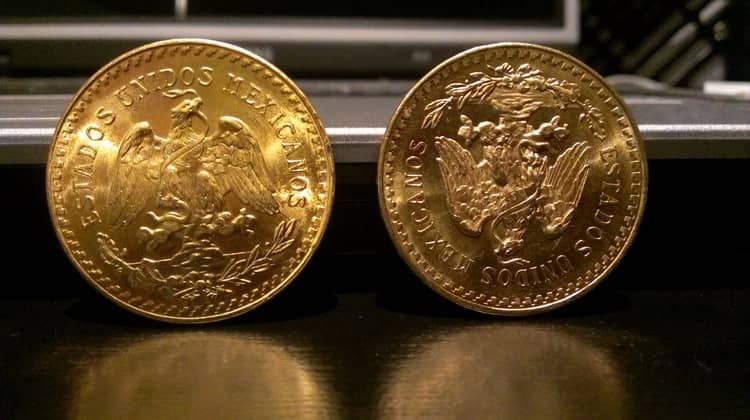
Mexican gold coins (commemorative and any other) have been issued from the middle of the XIX century to the present. Most coins are made of high quality gold, which is an attractive fact for investors and coin collectors. Mexican coins do not fall into the category of rare ones, because of their relatively low cost, it is best to start collecting coins with their purchase.
Mexican escudo
The first gold coins issued at the Mint of Mexico City were the escudos tied to the Spanish real. Coins were issued in denominations ½, 1, 2, 4, 8 escudos.
Characteristics of the coin
Production: Mint Mexico City.
Metal: .875 gold.
Weight: 1.69 g (½ escudo), 3.38 g (1 escudo), 6.67 g (2 escudos), 13.54 g (4 escudos), 27.07 g (8 escudos).
Obverse: On the obverse of the coin there is an image of an eagle with a snake in its beak. The inscription “REPUBLICA MEXICANA” is placed around the eagle.
Reverse: A hand holding a Phrygian cap on a stick, under it is an open book.

The first peso (1866-1867)
Soon after the declaration of independence of Mexico, the peso − national currency began to be issued. The first coin of those years was a sample of 1 silver peso. In gold, the coins were issued in 20 pesos denomination, today they are one of the rarest Mexican coins.
Characteristics of the coin
Production: Mint Mexico City.
Material: .875 gold.
Diameter: 35 mm.
Weight: 33.84 g.
Circulation: 8274 pcs.
Obverse: on the obverse side there is a portrait in profile of Maximilian I, the inscription “Maximiliano Emperador” is engraved around it.
Reverse: on the reverse side there is the crowned imperial emblem, the inscription “Imperio Mexicano”, as well as the year of production of the coin and denomination.
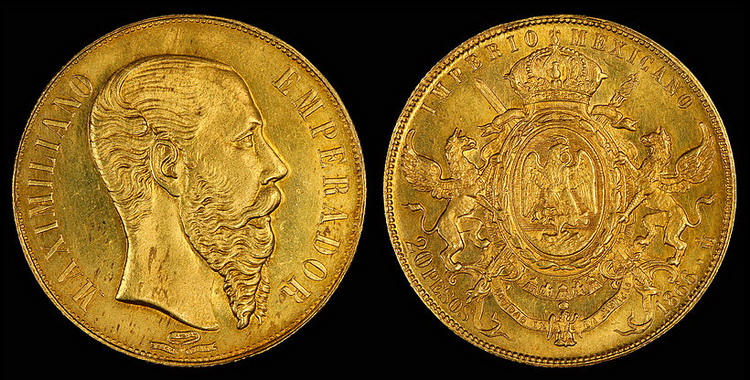
Peso issued in 1905-1970
In 1905, a monetary reform was carried out in Mexico, as a result of which the gold content in the coins had to be reduced to 49.36%. Despite this, the country managed to produce gold coins of good quality, which became the subject of collectors lust.
Characteristics of the coins
- 2 pesos denomination, regular issue (1919-1948). Weight 1.6 g, diameter 13 mm, the material used for the manufacture − gold .900.
- 2½ pesos denomination, regular issue (1918-1948). Weight 2.08 g, diameter 15.5 mm, the material used for the manufacture − gold .900.
- 5 pesos denomination, regular issue (1905-1955). Weight 4.16 g, diameter 19 mm, the material used for the manufacture − gold .900.
- 10 pesos denomination, regular issue (1905-1955). Weight 8.33 g, diameter 22.5 mm, the material used for the manufacture − gold.900.
- 20 pesos denomination, regular issue (1917-1959). Weight 16.6 g, diameter 27.5 mm, the material used for the manufacture − gold .900.
- 50 pesos denomination, regular issue (1921-1947). Weight 41.66 g, diameter 37 mm, the material used for the manufacture − gold .900.
- 50 pesos denomination “Winged Victory”, commemorative issue (1943). Weight 41.66 g, diameter 37 mm, the material used for the manufacture − gold.900.
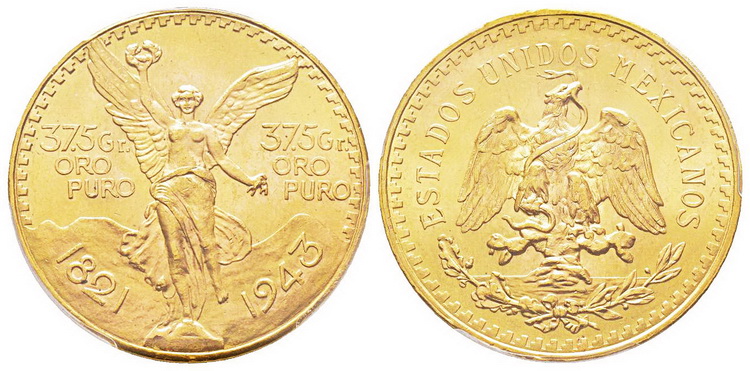
Modern mexican pesos
Nowadays, Mexico does not produce gold coins of regular coinage, instead of them there the commemorative samples, which attract the investors and coin collectors. They are coincide with important events in the history of the country.
Commemorative Series
- “FIFA World Cup”, 250 pesos denomination, years of issue 1985-1986. Weight 8.64 g, diameter 22, 8 mm. The material used in the manufacture − gold.900.
- “FIFA World Cup”, 500 pesos denomination, years of issue 1985-1986. Weight 17.28 g, diameter 22.8 mm. The material used in the manufacture − gold.900.
- “200 years of independence”, 200 pesos denomination, years of issue 2010. Weight 41.6 g, diameter 37 mm. The material used in the manufacture − gold.900
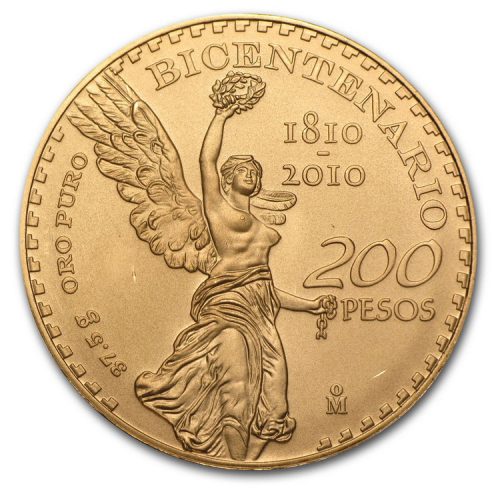
Gold Libertad
Gold Libertad are the investment coins of the purity of gold .999, have been issued since 1981 by the Mint in Mexico City. All coins of the series are most often sold as part of a set. On the obverse of the coins there is the emblem of Mexico, and on the reverse there is the winged Victoria, the ancient Roman goddess of victory, standing in front of the volcanoes Popocatepetl and Istaxiuatl. In addition to gold, Mexico releases silver libertad.
- A coin weighing 1 troy ounce, diameter − 34.5 mm.
- A coin weighing 1/2 troy ounces, diameter − 29 mm.
- A coin weighing 1/4 troy ounce coin, diameter − 23 mm.
- A coin weighing 1/10 troy ounces, diameter − 16 mm.
- A coin weighing 1/20 troy ounces, diameter − 13 mm.
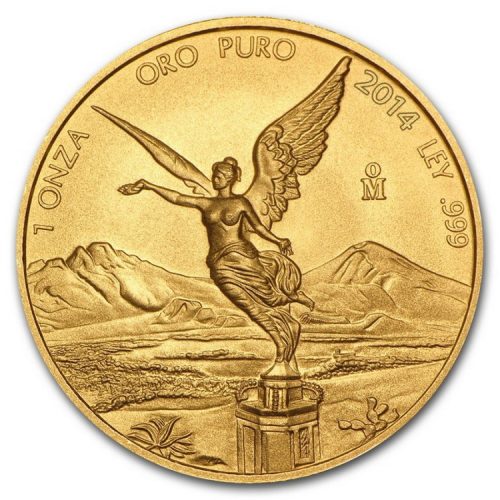
Cost of coins
Ancient gold Mexican pesos are in stable demand among coin collectors and investors. The cost of each sample varies depending on the place of sale, ranging from 100 to 1000 $ USD. More rare instances, such as collectible coins of the “football series”, can cost 1,200 $ USD. Also silver commemorative coins of Mexico, especially samples of the Silver “Aztec” series, are in good demand.
Interesting facts
- In 1993, due to hyperinflation, the Mexican government was forced to introduce a new currency instead of the old one; it received the uncomplicated name “Nuevo Peso”, which means “new peso”. New coins and banknotes were exchanged at the rate of 1 to 1000 relative to the old ones. The design of the new peso completely repeated the old one, but confusion was avoided when the central bank of Mexico stopped typing the word “Nuevo” on new coins and banknotes. Thus, the peso experienced a new birth.
- Some agencies in the border areas of the United States accept Mexican pesos as the local currency, for example, some Walmart cross-border stores, some border filling stations, such as the Circle K, and La Bodega Supermarkets in San Isidro on the border with Tijuana. In 2007, Pizza Patrón, a pizzeria chain in the southwestern United States, also began to accept this currency, which caused protests and disputes in the United States. With the exception of the border cities of the United States, Guatemala and Belize, Mexican pesos are generally not accepted as currency outside of Mexico.
- From time to time, one or another defective sample is found among the “libertad” coins, mostly they do not have the usual design elements, which is caused by excessive polishing. In addition, in 1883, several double and triple Victoria’s picture was issued on the reverse of coins. Also in 2015, collector Craig Magnussen discovered a 1985 coin weighing 1 troy ounce, in which Victoria was depicted with wings without separate feathers. In the same year, a small number of “libertad” weighing 2 troy ounces with torn Victoria wings on the reverse were produced.
- Before the financial crisis and the introduction of “nuevo”, a million pesos were called “melón” in local slang, which means “melon”. When replacing old money with the new ones from a million, three zeros were taken away, so now the old “melon” began to cost only a thousand pesos. Resourceful Mexicans came up with the name “milanesa” conforming to “melón” for a depreciated old melon, which means “chop in Milan”, this is one of the most popular dishes in the country.
- In general, Mexicans love to give gastronomic names to the coins and banknotes of their country. For example, fifty cents is colloquially called “toast”.
- At present, there are neither coins nor 25 pesos banknotes in Mexico; this amount is most often referred to as the obsolete word peseta.
Comments
No commens yet.